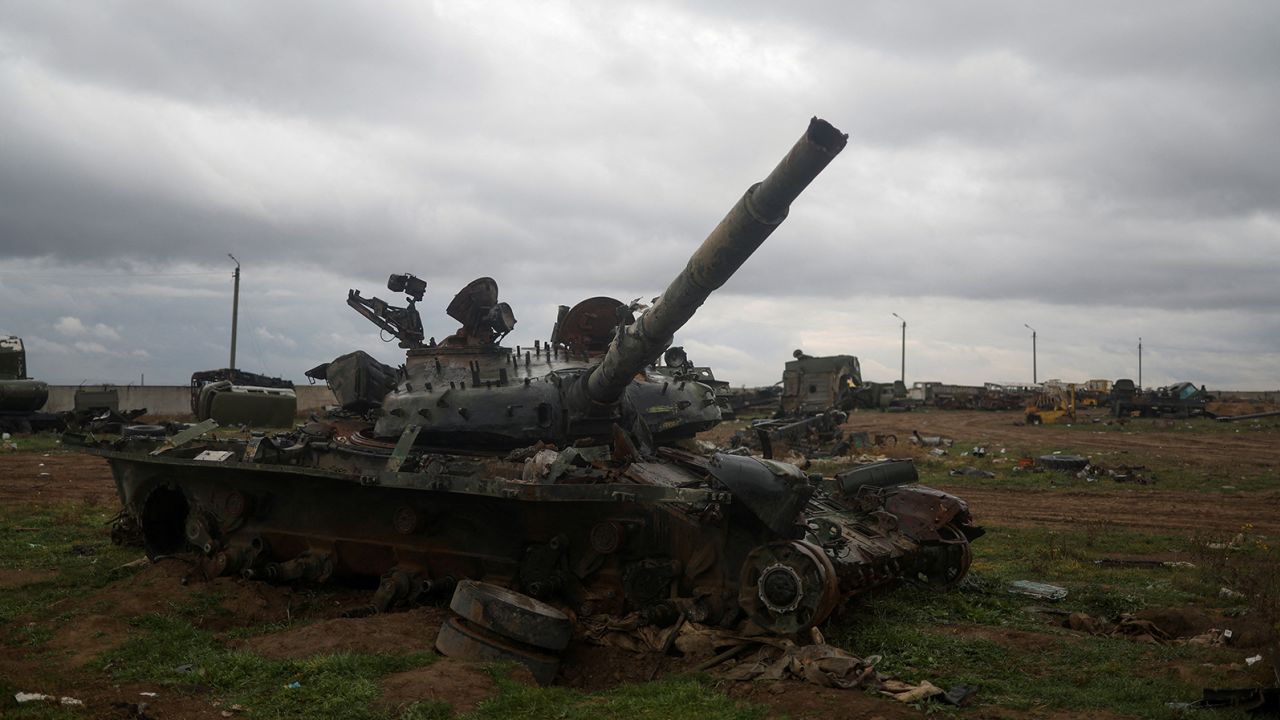Brad Lendon

A destroyed Russian tank is seen at a compound of an international airport after Russia's retreat from Kherson, in Chornobaivka, outside of Kherson, Ukraine, on November 16, 2022.Valentyn Ogirenko/Reuters/File
CNN —
Battlefield losses and Western sanctions have left the Russian military in a state of decline, but Moscow will still have enough firepower to extend the war in Ukraine, according to a new independent analysis.
The report from the Center for Strategic and International Studies gives stark numbers of Russian military losses – almost 10,000 units of key equipment such as tanks, trucks, artillery pieces and aerial drones, according to one estimate.
But it also says Russia can dip into Cold War-era and older stocks on the front lines to make up in numbers what it may have lost in technology.
“The quality of the Russian military in terms of advanced equipment will likely decline, at least over the near term,” the CSIS report says.
It notes how Russian losses of main battle tanks, especially modern ones, have been severe.

A captured Russian T-72B3 tank awaits repairs on February 13, 2023, at a warehouse in eastern Ukraine.John Moore/Getty Images
“Moscow is estimated to have lost anywhere from 1,845 to 3,511 tanks one year into the war,” the CSIS report says, with losses of its newer, upgraded T-72B3 main battle tank, first delivered in 2013, noted as especially damaging.
The Netherlands-based open source intelligence website Oryx says it has visual evidence of more than 500 variants of T-72B3 destroyed, damaged, abandoned or captured as of this week.
Western officials, speaking during a briefing Tuesday, also noted the pressure on the Russian tank fleet.
“They’re going backwards in terms of equipment,” the officials said of Russian armor, noting that T-55 tanks, introduced in 1948, are now turning up on the battlefield.
The CSIS report highlights the problem Russia faces in new tank construction, citing Russian media reports.
One tank plant, UralVagonZavod, can make about 20 tanks a month. But Russia loses, on average, almost 150 tanks of all types in Ukraine each month, it says.
Enter your email to sign up for CNN's "Meanwhile in China" Newsletter.
close dialog
What’s happening in China and what does it mean for the rest of the world?
And then there’s the lack of modern hardware.
The CSIS report says Moscow has to refurbish and put its decades-old tanks back into action because it just doesn’t have the resources to build new ones, with Western sanctions leaving it unable to source parts and tools needed to put together a modern tank.
‘Less reliable suppliers’
Sanctions have cut Russian access to optical systems – needed for tank gunners to pick out targets – ball bearings and machine tools, the CSIS report said.
Specifically for optical systems, Russia relied on French imports during its pre-war production, the report said.
With those imports cut off by sanctions, it’s forced to put older, less sophisticated gunner’s sights in even its most modern tanks, resulting in a possible loss of up to two kilometers in range, it said.
In the case of high-quality ball bearings – “critical to producing any type of moving vehicle,” the report said – 55% of Russia’s pre-war supply came from Europe and North America. With those sources now lost, it may try to make up the deficit with domestically produced supplies or imports of lower quality from China or Malaysia, the report said.
Either way, Russia can’t get the quality it did before the war.
“Moscow is under pressure to adapt, often turning to less-reliable and costlier suppliers and supply routes, lower-quality imports, or trying to reproduce Western components internally. This is likely hampering the rate and quality of Russian defense production,” the report said.
The loss of Western components is not just felt in tanks, the report says.
Manned and unmanned aircraft, missiles and electronic warfare equipment need modern, high-tech parts – including microchips – that Russian can’t source adequately from internal suppliers and has difficulty importing because of Western sanctions, it said.
But the report cautions that Ukraine and its Western supporters should not expect these supply problems to quickly stop the hostilities.
“Sanctions and export controls are not a silver bullet that will force Russia to bring the war to an end,” it said.
Russia still retains numerical advantages over Ukraine, the report said, because it has large inventories in reserve.
“Russia’s military capabilities still greatly outnumber those of Ukraine on most indicators, including man-, air-, land, and naval power,” the report says.
“While an accurate count of Moscow’s current military stocks is not available publicly, it has been roughly estimated that, as of February 2023, the total number of aircraft at the Kremlin’s disposal has been 13-15 times more than Kyiv’s. Russia has nearly 7-8 times more tanks and 4 times more armored fighting vehicles, while its naval fleet is 12-16 times larger than Ukraine’s,” it says.
The numerical advantages will enable Moscow to run a war of attrition over the next year, throwing numbers on the battlefield until Ukraine, even with fewer losses, runs out of hardware, the report says.
To offset the Russian numerical advantages, even of inferior weaponry, it is vital that Western countries keep technologically superior armaments flowing to Ukraine.
For instance, the older tanks are vulnerable to hand-held Javelin missiles, it says.
“This is the crux of this war in its second year: the Russian military can rely on its mass and continue feeding older or less than state-of-the-art technology as long as it thinks it can simply outlast the Western deliveries of weapons and systems to Ukraine,” the CSIS report says.
No comments:
Post a Comment